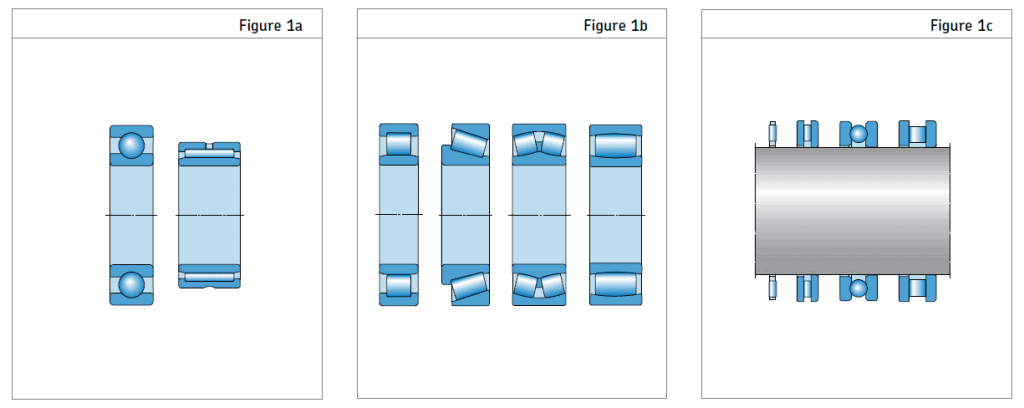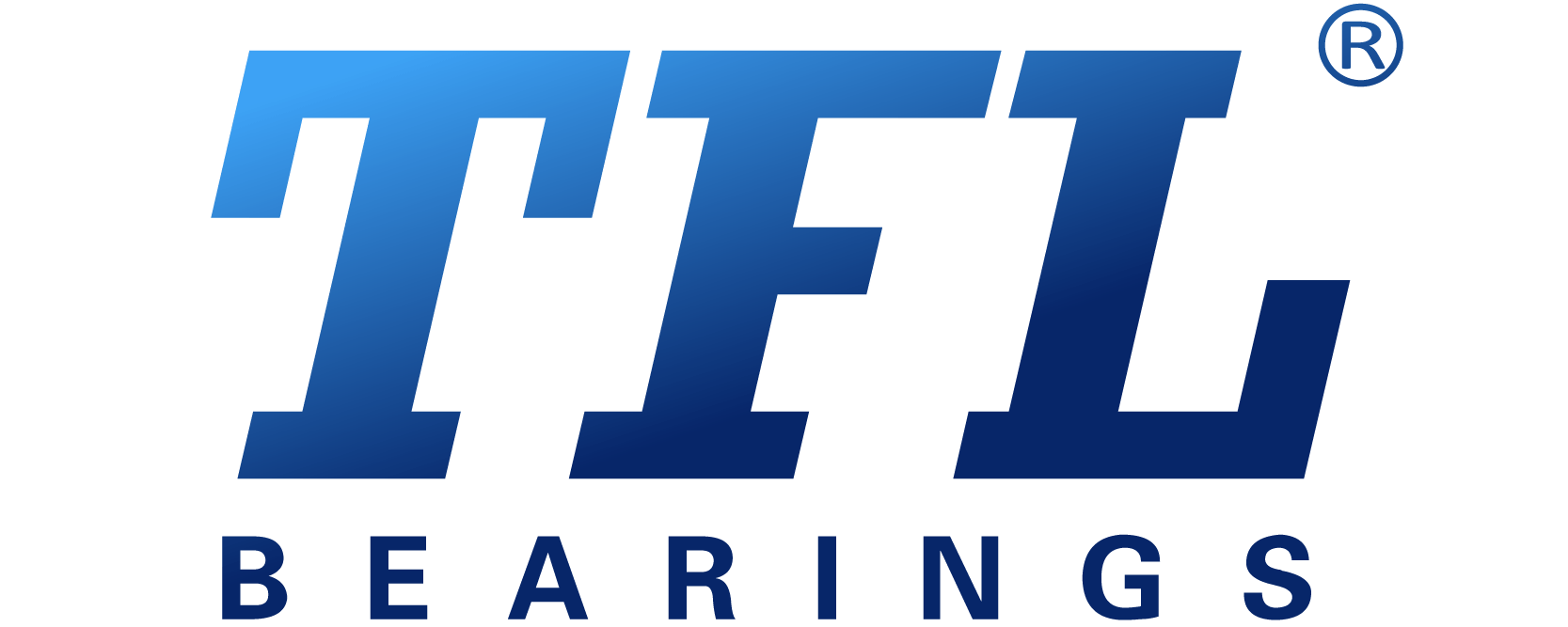SKF bearing designation
SKF bearing designation (nomenclature)
The designations of most SKF rolling bearings follow a bearing designation system. The complete SKF bearing vocabulary may consist of a basic designation with or without additional designations. The complete designation is always marked on the bearing package, whereas the marking on the bearing may be incomplete or deviate from the designation. The basic designation identifies:
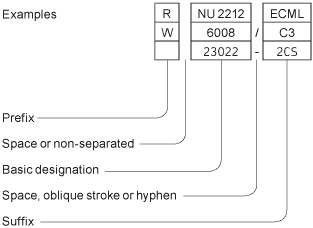
- SKF bearing type
- SKF basic design
- the boundary dimensions
Prefixes and suffixes identify bearing components or variants having a design and feature(s) that differ in some respect from the basic design.
Designation system for SKF standard metric ball and roller bearings
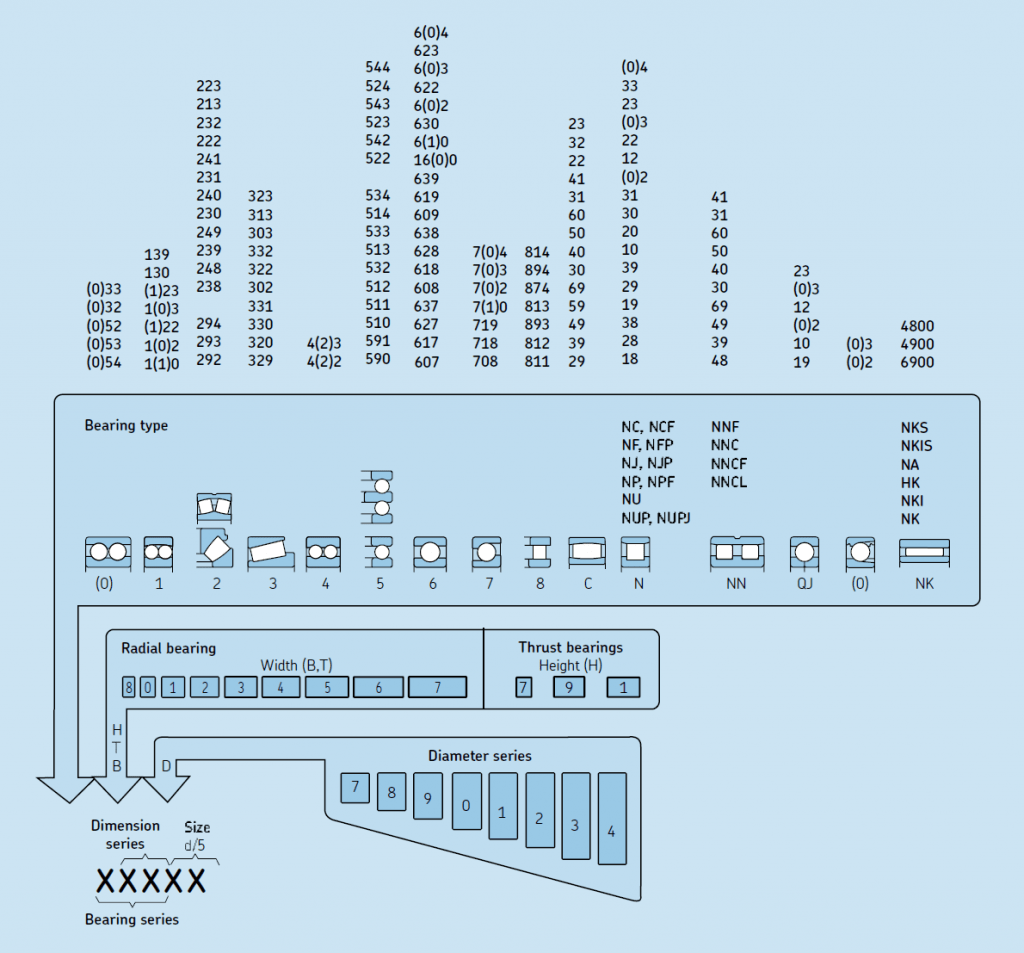
| Code | Bearing type | Code | Bearing type | Code | Bearing type |
| 0 | Double row angular contact ball bearing | 7 | Single row angular contact ball bearing | QJ | Four-point contact ball bearing |
| 1 | Self-aligning ball bearing | 8 | Cylindrical roller thrust bearing | T | Tapered roller bearing |
| in accordance with | |||||
| ISO 355:2007 | |||||
| 2 | Spherical roller bearing, spherical roller thrust bearing | C | CARB toroidal roller bearing | ||
| 3 | Tapered roller bearing | N | Cylindrical roller bearing. Two or more letters are used to identify the number of the rows or the configuration of the flanges, e.g. NJ, NU, NUP, NN, NNU, NNCF etc. | ||
| 4 | SKF double row deep groove ball bearing | ||||
| 5 | Thrust ball bearing | ||||
| 6 | SKF single row deep groove ball bearing | ||||
A basic SKF designation typically contains three to five digits. Some products, like cylindrical roller bearings, can have a combination of alphanumeric characters. The number and letter combinations have the following meaning:
- The first digit or letter, or combination of letters, identifies the bearing type and eventually a basic variant.
- The following two digits identify the ISO dimension series. The first digit indicates the width or height series (dimensions B, T, or H). The second digit identifies the diameter series (dimension D).
- The last two digits of the basic designation identify the size code of the bearing bore. The size code multiplied by 5 gives the bore diameter (d) in mm.
SKF diameter series designations
The matrix can only provide a rough guide so that in each individual case it is necessary to make a more qualified selection referring to the information given on the preceding pages or the detailed information in the text preceding each table section.
| Bearing type | Diameter series | ||
| 7, 8, 9 | 0, 1 | 2, 3, 4 | |
| Deep groove ball bearings | 617, 618, 619 | 60 | 2, 3 |
| 627, 628 | 160, 161 | 42, 43 | |
| 637, 638, 639 | 630 | 62, 63, 64, 622, 623 | |
| Angular contact ball bearings | 70 | 32, 33 | |
| 72, 73 | |||
| QJ 2, QJ 3 | |||
| Self-aligning ball bearings | 139 | 10, 130 | 12, 13, 112 |
| 22, 23 | |||
| Cylindrical roller bearings | NU 10, 20 | NU 2, 3, 4, 12, 22, 23 | |
| NJ 10 | NJ 2, 3, 4, 22, 23 | ||
| NUP 2, 3, 22, 23 | |||
| N 2, 3 | |||
| Needle roller bearings | NA 48, 49, 69 | ||
| Full complement cylindrical | NCF 18, 19, 28, 29 | NCF 30 | NCF 22 |
| roller bearings | NNC 48, 49 | NNF 50 | NJG 23 |
| NNCF 48, 49 | NNCF 50 | ||
| NNCL 48, 49 | |||
| Spherical roller bearings | 238, 239 | 230, 231 | 222, 232 |
| 248, 249 | 240, 241 | 213, 223 | |
| CARB toroidal roller bearings | C 39, 49, 59, 69 | C 30, 31 | C 22, 23 |
| C 40, 41 | C 32 | ||
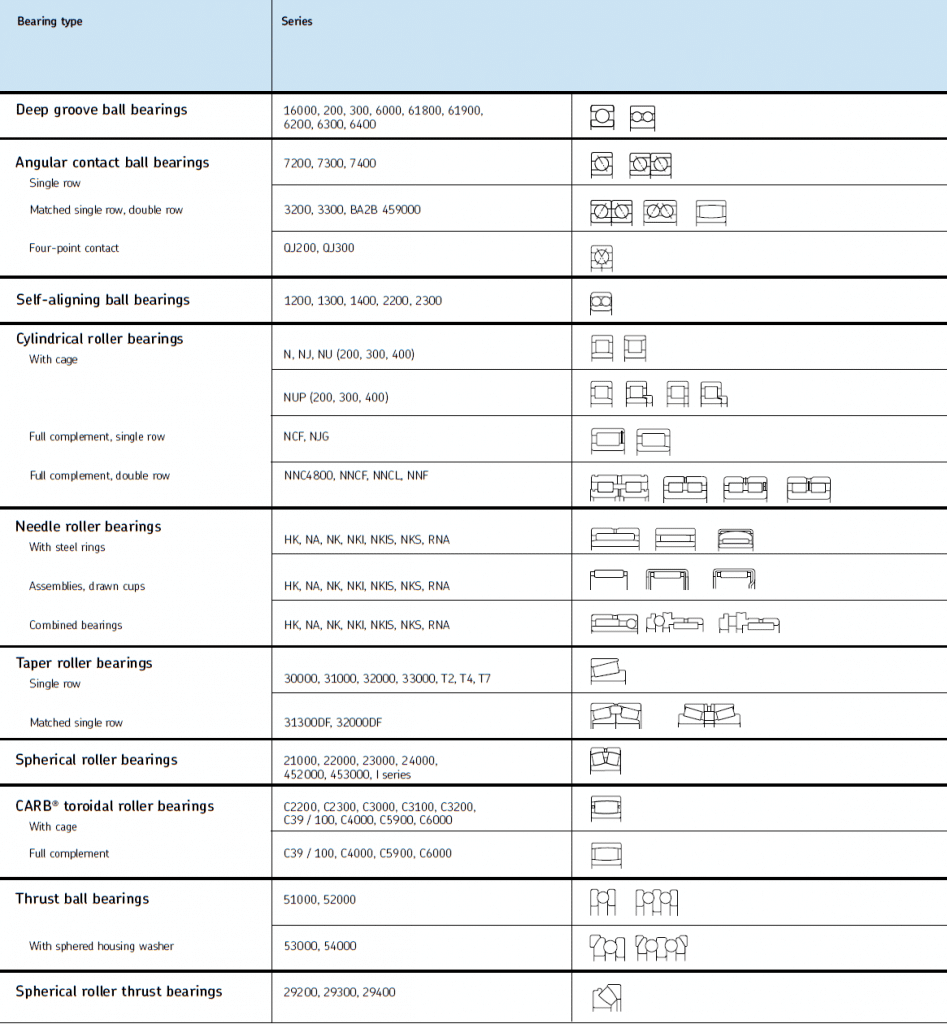
1) Bearings 604, 607, 608, 609 belong to diameter series 0,
bearings 623, 624, 625, 626, 627, 628 and 629 to diameter series 2,
bearings 634, 635 and 638 to diameter series 3
bearing 607/8 to diameter series 9
2) Bearing 108 belongs to diameter series 0,
bearings 126, 127, and 129 to diameter series 2,
bearing 135 to diameter series 3
The most important exceptions in the basic bearing designation system are:
- In a few cases the digit for the bearing type or the first digit of the dimension series identification is omitted.
- Bearings with a bore diameter of 10, 12, 15 or 17 mm have the following size code identifications: e.g. 6300-2RSH (d=10mm)
00 = 10 mm
01 = 12 mm
02 = 15 mm
03 = 17 mm - For bearings with a bore diameter < 10 mm, or ≥ 500 mm, the bore diameter is generally given in millimetres (uncoded). The size identification is separated from the rest of the bearing designation by an oblique stroke, e.g. 628/8-2Z (d = 8 mm) or 511/530 (d = 530 mm). This is also true of standard bearings in accordance with ISO 15:2011 that have a bore diameter of 22, 28 or 32 mm, e.g. 62/22 (d = 22 mm).
- For some bearings with a bore diameter < 10 mm, such as deep groove, self-aligning and angular contact ball bearings, the bore diameter is also given in millimetres (uncoded) but is not separated from the series designation by an oblique stroke, e.g. 608-2RSH/C3 (d=8mm) 629 or 129 (d = 9 mm).
- Bore diameters that deviate from the standard bore diameter of a bearing are uncoded and given in millimetres up to three decimal places. This bore diameter identification is part of the basic designation and is separated from the basic designation by an oblique stroke, e.g. 6202/15.875 (d = 15,875 mm = 5/8 in).
Series designations
Each standard bearing belongs to a given bearing series, which is identified by the basic designation without the size identification. Series designations often include a suffix A, B, C, D, or E or a combination of these letters. These letters are used to identify differences in internal design.
SKF bearing designations not covered by the basic system
The designations for certain SKF bearing types are either not covered, or are only partially covered.
SKF Y-bearings (insert bearings)
The designations for SKF Y-bearings differ somewhat from those described in the basic designation system and are covered in the relevant product section.
SKF Needle roller bearings
The designations for needle roller bearings do not fully follow the basic designation system and are covered in the relevant product section.
SKF tapered roller bearings
The designations for metric tapered roller bearings follow either the basic designation system or a designation system, established by ISO in 1977, covered in ISO 355:2007
Inch tapered roller bearings are designated in accordance with the relevant ANSI/ABMA standard. The designation system for tapered roller bearings is explained in the relevant product section.
SKF customized bearings
Bearings designed to meet a specific customer requirement are typically designated by a drawing number. The drawing number does not provide any information about the bearing.
SKF other rolling bearings
SKF rolling bearings not covered in the Ball bearings and Roller bearings sections, such as super-precision bearings, thin section bearings, slewing bearings, or linear bearings, follow designation systems that can differ significantly from the basic designation system.
SKF bushing bearings
The designation for SKF bushing bearings identifies SKF bushings type, size, material, and lubrication.
SKF Bearing type
Each bearing type displays characteristic properties based on its design, making it more or less appropriate for a given application. For example, deep groove ball bearings can accommodate moderate radial loads as well as axial loads. They have low friction and can be produced with high precision and in quiet running variants. Therefore they are preferred for small and medium-sized electric motors.
Spherical and toroidal roller bearings can carry very heavy loads and are self-aligning. These properties make them popular, for example, in heavy engineering applications, where there are heavy loads, shaft deflections, and misalignments.
In many cases, however, several factors have to be considered and weighed against each other when selecting a bearing type so that no general rules can be given. The information provided here should serve to indicate which are the most important factors to be considered when selecting a standard bearing type and thus facilitate an appropriate choice:
• Available space
• Loads
• Misalignment
• Precision
• Speed
• Quiet running
• Stiffness
• Axial displacement
• Mounting and dismounting
• Integral seals
An overview of the standard bearing types, their design characteristics, and their suitability for the demands placed on a given application will be found in the matrix on pages 12 and 13. Detailed information on the individual bearing types, including their characteristics and the available designs, will be found in the sections dealing with individual bearing types. Bearing types that are not included in the matrix are generally only used for a few well-defined applications.
The matrix permits only a relatively simple classification of bearing types. The limited number of symbols does not allow a clear differentiation. Some properties do not depend solely on bearing design. For example, the stiffness of an arrangement incorporating angular contact ball bearings or taper roller bearings also depends on the applied preload and the operating speed, which is influenced by the precision of the bearing and its associated components and the cage design. Despite its limitations, the matrix on pages 12 and 13 should enable an appropriate comparison of bearing types. It should also be considered that the total cost of a bearing arrangement and inventory considerations could also influence the final choice.
Other important criteria to be observed when designing a bearing arrangement – load carrying capacity and life, friction, permissible speeds, bearing internal clearance or preload, lubrication, sealing, etc. – are dealt with in the SKF Rolling bearings catalog (10000 EN).
Available space
In many cases, one of the principal dimensions of a bearing – the bore diameter – is predetermined by the machine’s design and the shaft diameter. For small-diameter shafts, all types of ball bearings can be used. The most popular is deep groove ball bearings; needle roller bearings are also suitable (Figure 1a). For large-diameter shafts, cylindrical, taper, spherical and toroidal roller bearings are available, as well as deep groove ball bearings (Figure 1b).
When radial space is limited, bearings with a small cross-section, particularly those with a low cross-sectional height, should be chosen, i.e., bearings in the 8 or 9 diameter series. For purely axial loads, needle roller and cage thrust assemblies (with or without washers), as well as thrust ball bearings and cylindrical roller thrust bearings, can be used (Figure 1c).
